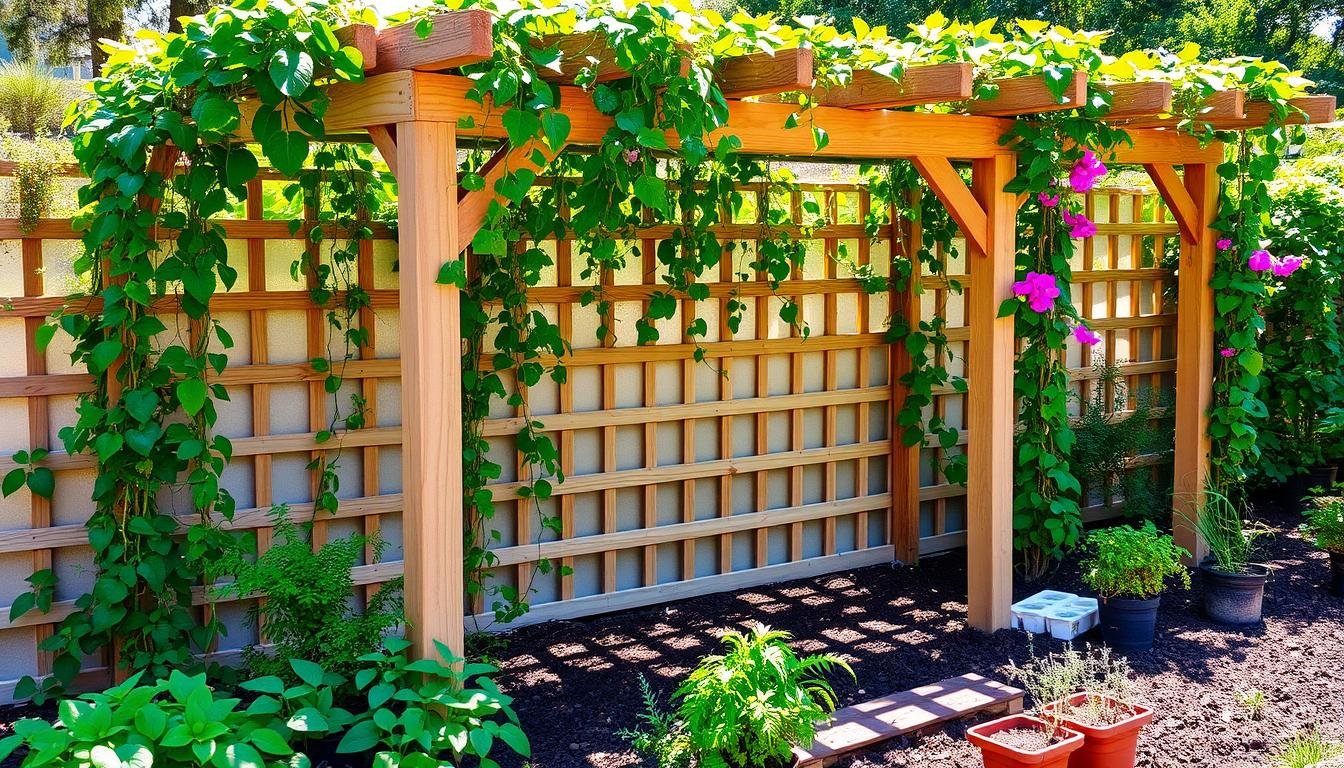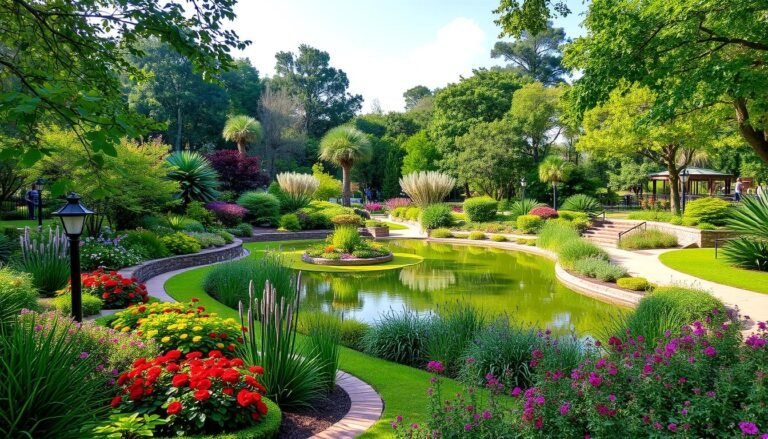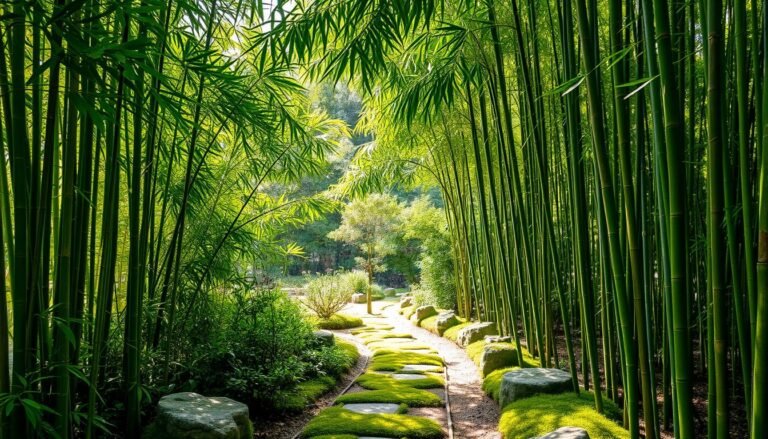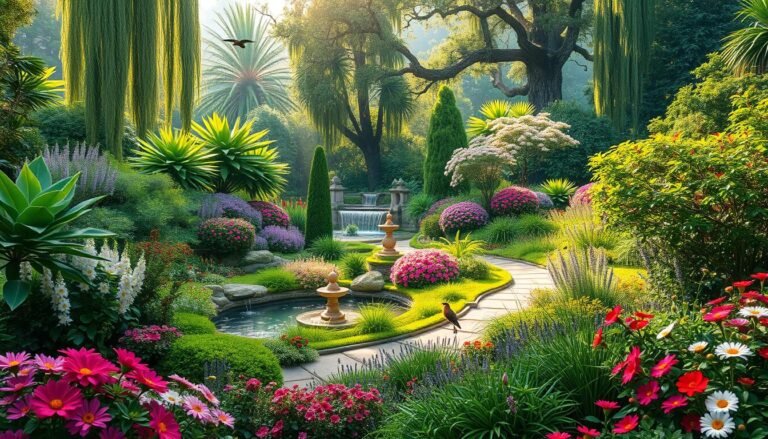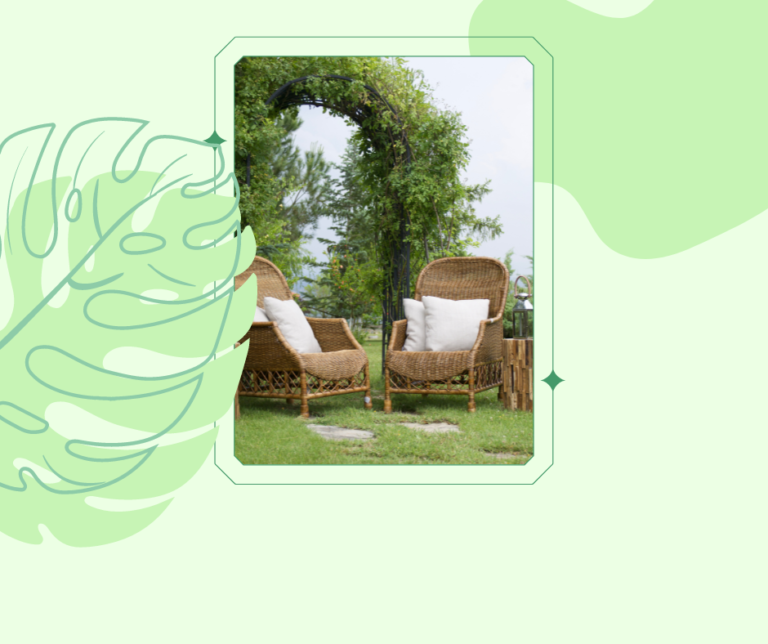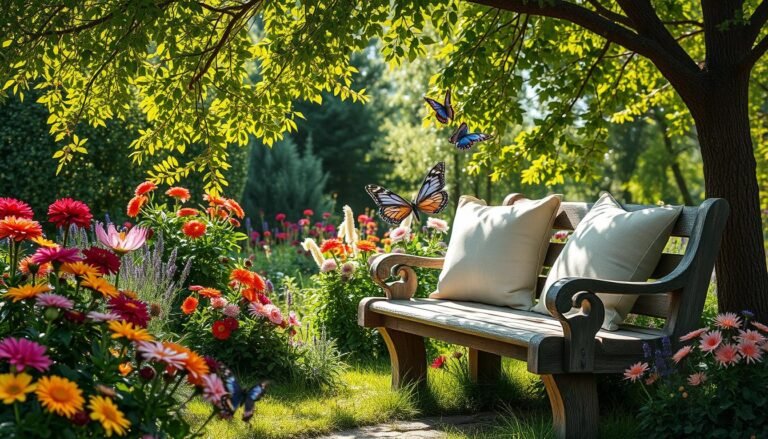Elevate Your Garden: The Ultimate Guide to Garden Trellises
Imagine a garden where plants grow up towards the sky, making your outdoor area a living work of art. Garden trellises are the key to making your gardening dreams come true. They’re perfect for both experienced gardeners and weekend hobbyists, changing how you grow and enjoy plants.
Garden trellises do more than just support plants. They make your garden look amazing and use space well. They can hold up big tomato vines or show off beautiful climbing flowers. These structures are like living parts of your garden, bringing it to life.
Think about turning a small patio or backyard into a green oasis. The right trellis can make vertical gardens that save space and add beauty to your outdoor area. These gardens are not only space-saving but also add excitement and depth to your space.
Table of Contents
What is a Garden Trellis?
A garden trellis is more than a simple support. It’s a versatile tool that changes your outdoor area. It lets plants grow up, adding beauty to your garden.
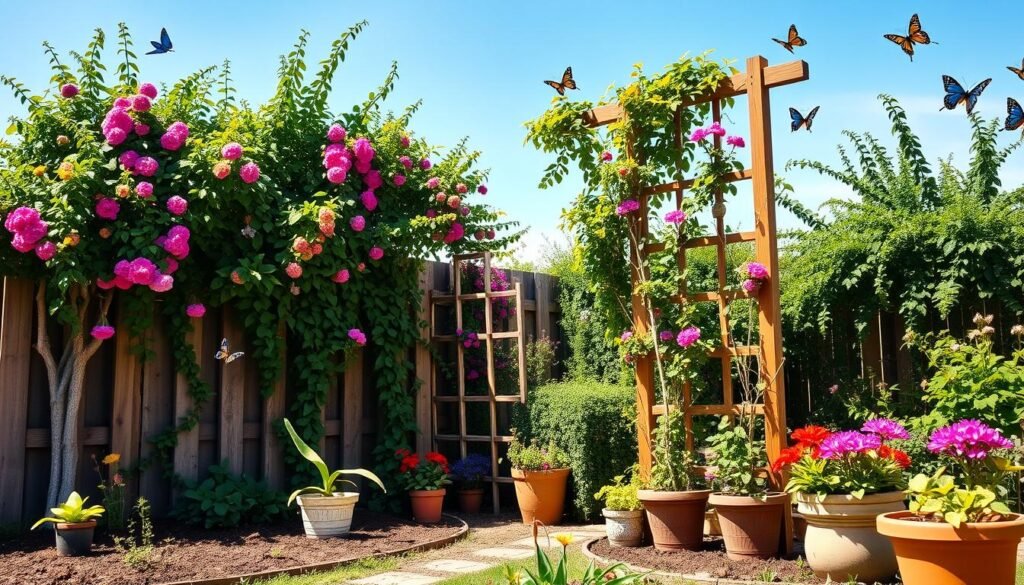
Definition and Purpose
A vertical gardening trellis is key for climbing plants. It lets them grow up, saving space and making your garden look amazing. Trellises come in many styles, supporting everything from flowers to veggies.
“Trellises turn ordinary gardens into vertical masterpieces of greenery and design.”
Benefits for Plants
- Improved sunlight exposure (up to 70% more direct light)
- Enhanced air circulation reducing disease risk
- Easier harvesting for fruiting plants
- Maximized garden space through vertical growth
Aesthetic Appeal
Garden trellises are not just useful – they’re also beautiful. They can:
- Create privacy screens
- Define garden sections
- Add architectural interest
- Showcase climbing plants
| Trellis Type | Best Plant Matches | Garden Impact |
|---|---|---|
| Wooden Lattice | Roses, Clematis | Rustic Charm |
| Metal Grid | Jasmine, Grape Vines | Modern Elegance |
| Arch Trellis | Wisteria, Sweet Peas | Romantic Entrance |
Choosing the right garden trellis can greatly improve your outdoor space. It can turn simple plants into stunning vertical gardens.
Types of Garden Trellises
Exploring garden trellises opens up exciting possibilities for your outdoor space. Different designs can transform your garden. They provide support for climbing plants and add visual interest and functionality.
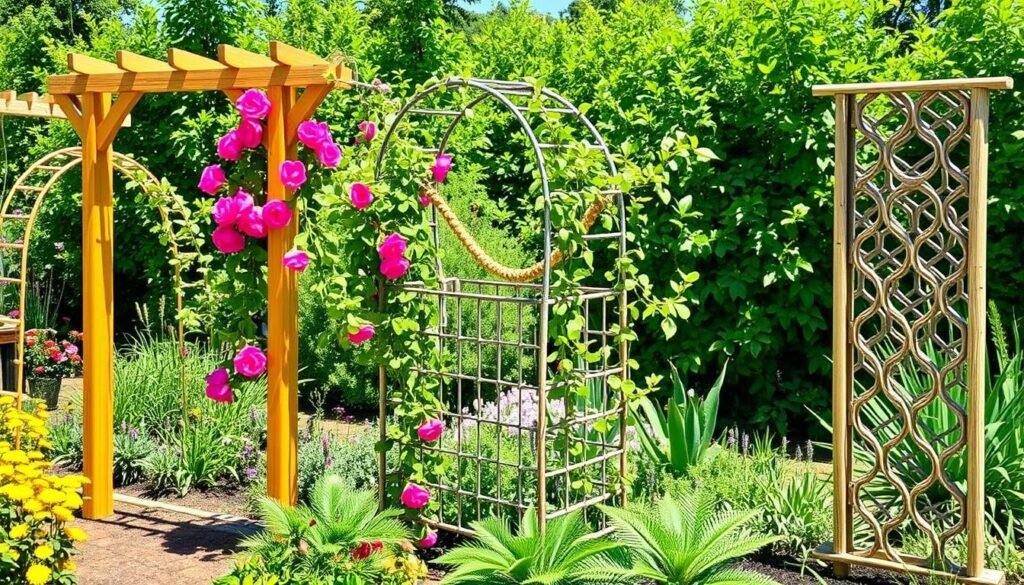
Garden trellis ideas come in various styles to suit every gardener’s needs. Let’s dive into the most popular types that can elevate your DIY garden trellis project:
Freestanding Trellises: Flexible Garden Companions
A decorative trellis that stands alone offers maximum versatility. These structures can be:
- Easily repositioned around your garden
- Perfect for supporting climbing roses and clematis
- Available in multiple materials like wood, metal, and bamboo
Wall-Mounted Options: Space-Saving Solutions
Ideal for small gardens, wall-mounted trellises maximize vertical space. They transform blank walls into living green displays, supporting delicate climbers like:
- Honeysuckle
- Ivy
- Passionflower
Archways and Arbors: Dramatic Garden Entrances
Create a stunning garden focal point with arch trellises. These structures provide:
- Elegant pathway transitions
- Supportive structures for heavy climbing plants
- Natural privacy screens
Hanging Trellises: Compact Gardening Magic
Perfect for container gardens and small spaces, hanging trellises allow you to grow vertically. They work wonderfully for:
- Balcony gardens
- Herb cultivation
- Decorative vine displays
“A well-chosen trellis transforms a simple garden into a living work of art.” – Garden Design Expert
Choosing the Right Material
Choosing the right material for your garden trellis can change your outdoor space. It gives climbing plants the support they need. The best choice depends on durability, looks, and your gardening needs.
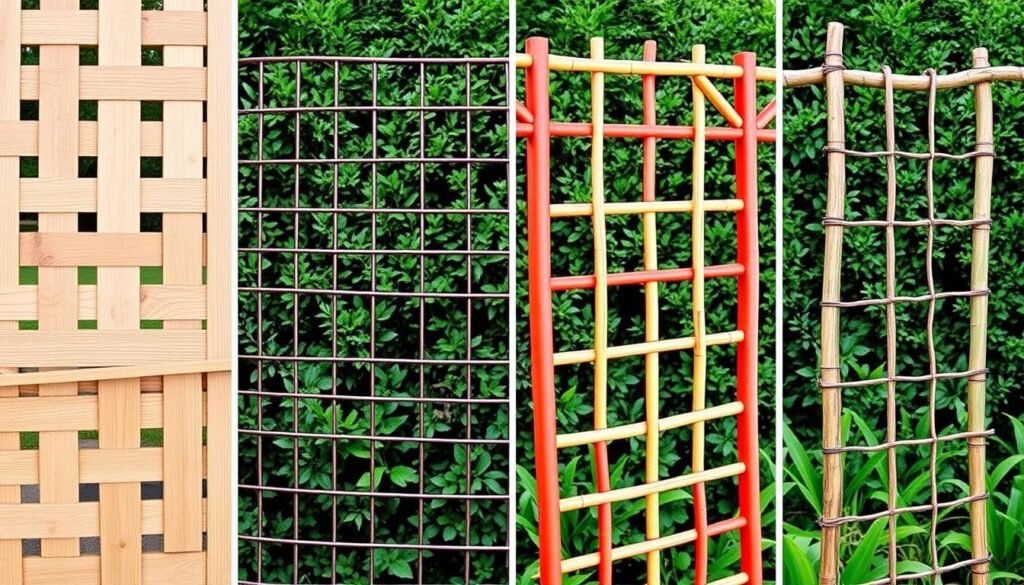
There are several main materials for garden trellises, each with its own traits:
Wooden Trellises: Natural Elegance
A wooden trellis adds classic charm to any garden. They are versatile and can be tailored to fit your garden design. Here are some wood trellis benefits:
- Affordable and widely available
- Can be painted or stained to match garden aesthetics
- Provides a warm, natural look
“Wood trellises create a timeless connection between plants and garden architecture.” – Garden Design Expert
Metal Garden Trellises: Durability Meets Style
Metal garden trellises are known for their strength and long life. Galvanized or powder-coated steel options are great for supporting heavy plants.
- Resistant to weather and decay
- Available in detailed designs
- Ideal for long-lasting garden structures
Plastic and Composite Options: Low-Maintenance Solutions
For those who want easy-to-maintain options, plastic and composite trellises are good choices. They resist weather damage and need little care.
When picking your garden trellis material, think about plant weight, local weather, and your garden’s design. Each material has its own benefits to help your plants grow well.
Garden Trellis Designs
Garden trellises add height and beauty to your outdoor space. They can be decorative or a DIY project. The right design can make your garden look amazing.
Classic and Traditional Styles
Traditional garden trellises add elegance to your garden. They often have:
- Intricate lattice patterns
- Ornate metalwork details
- Fan-shaped configurations
- Elegant wooden frameworks
Modern and Minimalist Designs
Modern garden trellises are sleek and stylish. They focus on:
- Clean geometric shapes
- Streamlined materials
- Monochromatic color schemes
- Simple structural elements
Custom and DIY Trellis Designs
DIY garden trellis projects let you express your creativity. You can use:
- Repurposed old window frames
- Bamboo canes
- Wooden pallets
- Curved or wavy top structures
“A well-designed trellis can be the architectural backbone of your garden, providing both function and artistic expression.”
| Trellis Design Type | Key Characteristics | Best Suited For |
|---|---|---|
| Lattice Trellis | Intricate crisscross pattern | Climbing roses, clematis |
| Modern Wire Trellis | Minimalist geometric design | Contemporary gardens |
| Rustic Wooden Trellis | Natural, organic appearance | Cottage and traditional gardens |
Choose a trellis that fits your garden’s style and supports your plants.
Best Plants for Trellises
Choosing the right climbing plants can turn your garden trellis into a masterpiece. A well-picked trellis can add beauty and make your garden more interesting. It’s like creating a living art piece.
Climbing Flowers for Vibrant Displays
Make your garden trellis stand out with these amazing flowering climbers:
- Clematis: Stunning varieties reaching 20-30 feet tall
- Climbing Roses: Elegant blooms spanning 8-20 feet
- Jasmine: Fragrant white flowers climbing up to 6 feet
- Mandevilla: Brilliant tropical flowers growing 3-8 feet
- Honeysuckle: Colorful vines reaching up to 20 feet
Vegetables and Fruits for Functional Trellises
Turn your trellis into a productive garden with these edible climbers:
| Plant | Height | Fruit Yield |
|---|---|---|
| Pole Beans | 6-8 feet | 2-3 pounds per plant |
| Cucumbers | 5-7 feet | 8-10 cucumbers per plant |
| Grape Vines | 15-20 feet | 10-20 pounds per vine |
Decorative Vines for Year-Round Interest
Some climbing plants are beautiful all year round:
- Virginia Creeper: Dramatic foliage reaching 15-20 feet
- Star Jasmine: Evergreen climber with white flowers
- Wisteria: Dramatic purple clusters growing 15-20 feet
“A trellis transforms ordinary gardens into vertical landscapes of beauty and productivity.” – Garden Design Expert
When picking climbing plants, think about sunlight, climate, and how much care they need. Your trellis can become a lively, beautiful part of your garden. It can even give you fresh food.
How to Install a Garden Trellis
Building a DIY garden trellis needs careful planning and doing. It’s important for climbing veggies or pretty vines. A well-installed trellis will be strong and look great all season.
First, get your tools and materials ready. For a great trellis project, you’ll need:
- Fence posts
- Wire cutters
- Hammer
- Galvanized fence panels
- Garden twine or wire
Site Preparation
Choosing the right spot is key for your trellis. Think about these things:
- Check if your plants need a lot of sunlight
- Look at the soil and how well it drains
- Make sure the ground is even and solid
- Measure the area for when your plants get big
Installation Steps
The steps to install your trellis depend on its design. For freestanding ones, do this:
- Dig holes 12-18 inches deep for the posts
- Put the fence posts in the ground
- Attach the panels with wire or screws
- Make sure the posts are straight and stable
Tips for Stability
It’s important for your plants to have a stable trellis. Pro tip: Think about how heavy your plants will be. Big climbers like squash need extra support.
“A well-installed trellis transforms your garden from ordinary to extraordinary” – Garden Design Magazine
For trellises on walls, use strong anchors and screws. In windy places, you might need to anchor the ground to keep it from falling.
Maintenance Tips for Trellises
Keeping your garden trellis in good shape is key for its life and your plants’ health. Whether it’s wooden or metal, regular care stops damage. This keeps your garden looking great and working well.
Cleaning and Care Basics
Start with regular cleaning and checks to maintain your trellis. Each material needs its own care:
- Wooden trellises need annual cleaning with mild detergent
- Metal garden trellises require rust prevention treatments
- Plastic trellises can be washed with soap and water
Repair and Refurbishment Strategies
Fixing small problems early can prevent big damage. Here are some repair tips:
- Check for loose screws or connections
- Inspect for signs of rot or rust
- Replace damaged lattice pieces promptly
- Apply protective coatings as needed
| Trellis Material | Maintenance Frequency | Key Care Steps |
|---|---|---|
| Wooden Trellis | Annually | Clean, inspect for rot, apply wood preservative |
| Metal Trellis | Twice a year | Check for rust, touch up with rust-resistant paint |
| Plastic Trellis | As needed | Clean with soap, check for cracks |
“A well-maintained trellis is the backbone of a thriving vertical garden.” – Gardening Expert
By spending a bit of time on upkeep, your trellis will stay strong and beautiful for many years.
Decorating Your Trellis
A decorative trellis is more than just a plant support. It’s a canvas for creativity in your garden. By adding design elements, you can make an ordinary trellis a stunning focal point. It will capture attention and enhance your outdoor look.
Adding Magical Lighting
Light up your garden trellis with creative lighting. It will transform your outdoor space after sunset. Here are some enchanting options:
- Solar-powered string lights woven through trellis structures
- Hanging lanterns with warm LED bulbs
- Micro fairy lights creating a soft, ethereal glow
Incorporating Hanging Planters
Enhance your trellis with lightweight hanging planters. They add depth and visual interest. Choose containers that match your trellis and garden style.
| Planter Type | Best Plants | Weight Consideration |
|---|---|---|
| Ceramic Pots | Trailing Herbs | Light to Medium |
| Macramé Hangers | Succulents | Very Light |
| Metal Baskets | Seasonal Flowers | Medium |
Seasonal Decoration Inspiration
Make your trellis dynamic with seasonal decorations. Each season offers a chance to refresh your garden’s look.
“A well-decorated trellis is like a living piece of art that changes with nature’s rhythm.” – Garden Design Expert
- Spring: Pastel ribbons, butterfly ornaments
- Summer: Vibrant flower garlands, wind chimes
- Autumn: Dried leaf arrangements, mini pumpkins
- Winter: Evergreen wreaths, frosted pinecone clusters
Garden Trellis Ideas for Small Spaces
Turn tiny outdoor spots into lush green havens with clever vertical gardening trellis designs. When space is tight, going up is the best strategy. Small areas can become lively, fruitful gardens with the right trellis.
There are creative ways to use trellises in small outdoor spots. These designs help you use every inch of your garden, balcony, or patio.
Vertical Gardening Concepts
Vertical gardening makes small spaces bloom by letting plants grow up. Here are some ideas for small trellises:
- Wall-mounted trellises that use vertical space
- Foldable trellises for tight spots
- Container trellises for potted plants
- Corner fan-shaped trellises for tricky areas
Compact Trellising Solutions
There are smart ways to create beautiful vertical gardens in tight spots:
| Trellis Type | Space Requirements | Best Plants |
|---|---|---|
| Hanging Wall Trellis | Minimal wall space | Jasmine, Clematis |
| Balcony Railing Trellis | Railing width | Tomatoes, Beans |
| Tiered Planter Trellis | Small ground footprint | Climbing Roses, Ivy |
“In small gardens, every vertical inch counts. A well-designed trellis can transform a cramped space into a lush, green retreat.” – Garden Design Expert
For vertical gardening to succeed, pick the right plants. Go for light climbers that won’t weigh down your trellis. With a bit of creativity and planning, even the smallest spots can become amazing green spaces.
Using Trellises in Landscape Design
Landscape design lets you change your outdoor space with garden trellis ideas. Trellises make your yard look better and work better. They can make your yard private and interesting to look at.
Enhancing Privacy with Vertical Gardening Trellises
Getting a private outdoor area is easy with the right trellis. Here are some tips:
- Install trellises along property lines
- Use evergreen climbers for year-round coverage
- Select tall, dense vine varieties
- Combine trellises with strategic plantings
Creating Powerful Focal Points
Trellises can turn simple landscapes into amazing outdoor rooms. They draw your eye and add interest in new ways.
| Trellis Location | Design Impact |
|---|---|
| Garden Path End | Creates dramatic visual terminus |
| Entrance Arch | Frames entryway beautifully |
| Between Garden Zones | Defines separate outdoor spaces |
“A well-designed trellis is like a living sculpture that transforms your landscape.” – Landscape Design Expert
When picking a trellis, think about your home’s style and yard. Wooden trellises offer warm, organic lines, and metal ones are sleek and modern. The goal is to make a design that looks planned and fits well.
Trellises in Sustainable Gardening
A vertical gardening trellis is more than a plant support. It’s a key tool for sustainable gardens. It turns a simple area into a thriving space for plants and wildlife.
Plant trellises help support biodiversity. Plants like Kentucky Wonder pole beans attract pollinators and provide shelter. They also create homes for small creatures.
Well-designed trellises offer many benefits. They help cool cities by adding green spaces and improving air quality. They also save water, reduce soil erosion, and use land more efficiently.
Choosing a thoughtful trellis design does more than grow plants. It builds a strong, connected garden ecosystem. This ecosystem helps the environment and preserves biodiversity.

